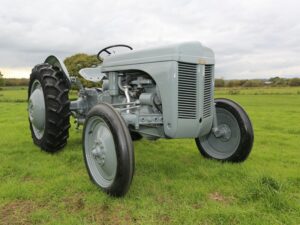Machine versatility, making the most of inputs, and soil health were key themes at the two-day Midlands Machinery Show, which attracted a large number of visitors.
“It has been superb – the best Midlands Machinery Show we’ve ever been to; our first was in 2016,” said Rhun Jones, owner of Grange Machinery whose low disturbance cultivators attracted strong interest from farmers. “We’ve been pushing into strip tillage in the last two years for maize, sugar beet and oilseed rape. We’re targeting the veg and brassica sector in the next 12 months – we are all looking to be greener about the way we grow crops and reduce the carbon footprint – the less soil inversion the better.”
The company also won the Best Agricultural Machinery Stand at the show.
There was versatility in abundance at the large and compact demo areas. In the large agricultural machinery demo area, the Manitou ULM 412 telehandler was put through its paces at its first demonstration. “It is a very lightweight model with a transportable weight of less than three tonnes which can be loaded onto a trailer with a PTAC of 3,500kg,” said area sales manager Manitou UK, Glyn Wallace. “It is 1.49m wide and 1.92m high and comes in two versions with lifting capacities of 1.25t and 1.5t, respectively, with a lifting height of 4.30m.”
In the compact demo area, the new Avant 645i was shown moving wood and bales. It is the most powerful compact loader on the market, according to Avant area sales manager Richard Jenkins. “It is fully stage five emissions compliant and can operate more than 250 attachments. It can work across many different enterprises and diversifications like agriculture, construction, forestry and equestrian.”
At P & J Peck, speed is of the essence with two brand new JCBs on display – the 4220 Fastrack Icon and JCB Agri Pro. Peck’s Graeme Matthews said both are capable of 50kph road speeds. “The 4220 has also had lots of cab upgrades with a fully integrated screen and isobus compatibility including factory set GPS solutions.”
Speaking at the NFU Environment conference, held in tandem with the Midlands Machinery Show, Jack Watts, NFU chief value chain analyst spoke about finding the value in regenerative farming with four principles in mind. “Firstly, take the long view – you won’t see returns next year – we’re talking five years plus. Secondly, work out where the value lies – is it soil health, for example? Next measure performance and understand how to manage it – ideas could be using crop sensors or sap testers. Finally, value the resilience a regenerative system can bring – the industry could be guilty of measuring production rather than optimising resilience.”
For farmers looking for advice on optimising business resilience, Brown & Co is offering free support, funded by Defra. “It is about reviewing the farm business – looking at strengths and weaknesses and how it benchmarks against others,” said partner James Walton.
Although grain prices remain firm, growers continue to be concerned about input prices, particularly electricity, said Woldmarsh group chief executive, Stuart McKenzie. “We are seeing farmers looking longer term and planning for future high prices. Some are looking at investing in 10s of acres of solar panels rather than the length of a shed. But a stumbling block can be connecting to the grid – not every farm has access and it can cost half a million to upgrade the connection.”
JRH Water Management has seen business come its way as farmers have sought to build more sheds, with planners in catchment sensitive farming areas asking more questions about where rainwater is going when it drains off roofs and whether it could contribute to flooding. “We can design and retrofit systems and tanks that mean 90% of water is captured,” says JRH engineer Nathan Jordan. “The captured water can be used for livestock, spraying or washdown.”
Main sponsor Chandlers saw a good footfall on its stand, said Valtra dealer principal Sean Stansfield. “Our stands were very busy and we had good enquiries across the team.”
Sharmans marketing executive Hazel Cooper said there had been lots of visitors to the company’s stand with the JCB Fastrack Icon attracting particular attention.
“There were a lot of people here,” said Andrew Dixon, Ripon Farm Services dealer development manager, Kramer. “But it wasn’t just the volume, they were quality customers – existing and potential.”
With such a comprehensive display of machinery, together with a wealth of advice during these turbulent times, the Midlands Machinery Show proved a worthwhile day out for all. “Visitors have had a fantastic day out watching the demos, gathering advice and ideas and taking part in some unique off-road and HGV driving experiences.
“Most Importantly, it has given them the opportunity to plan their next machinery investments,” said Elizabeth Halsall, events, show and development manager, Newark and Nottinghamshire Agricultural Society.
Editors’ Notes
About the show
The Midlands Machinery Show is organised by the Newark and Nottinghamshire Agricultural Society (NNAS). It is a platform for small, medium and large agricultural businesses to show their diverse range of machinery and innovation to those who work and have an interest in agriculture. It typically attracts around 300 exhibitors, including machinery manufacturers, regional dealers, and supporting businesses.
NNAS is an agricultural charity; its objectives include promoting and organising the show, as well as supporting young people with careers in agriculture, through its annual apprentice awards.
Contact for further information:
Elizabeth Halsall
Events, Show and Development Manager
Newark and Nottinghamshire Agricultural Society
Organiser of Midlands Machinery Show T: 01636 705 796 E: [email protected] www.midlandsmachineryshow.com






